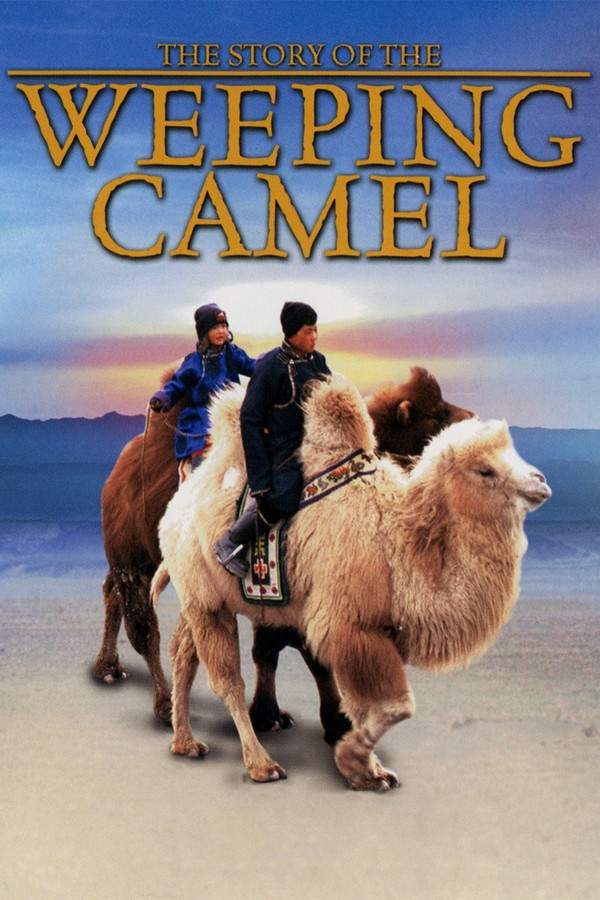
The Story of the Weeping Camel 2004
Directed by

Byambasuren Davaa
Made by

THINKFilm
Test your knowledge of The Story of the Weeping Camel with our quiz!
The Story of the Weeping Camel Plot Summary
Read the complete plot summary and ending explained for The Story of the Weeping Camel (2004). From turning points to emotional moments, uncover what really happened and why it matters.
During the vibrant Spring season, a family of nomadic shepherds diligently aids in the births of their precious camel herd. Their journey takes a challenging turn when the last camel faces a protracted labor that drags on for two long days. Ultimately, with the support and intervention of the family, a rare white calf is born, marking this mother camel’s first experience with calving. Unfortunately, despite the heartfelt efforts of the shepherds, the mother turns away from her newborn, rejecting it and failing to establish that crucial care-bond.
In a bid to restore balance and harmony, the nomadic family reaches out to a group of lamas, seeking their spiritual counsel. The lamas engage in a remarkable ritual using bread or dough effigies (known in Standard Tibetan as torma), representing the mother, the calf, and each family member. The ceremony commences with the resonant sound of a sacred horn, accompanied by the gentle ringing of bells held by the lamas, some armed with a vajra. This profound rite unfolds with members of the extended nomadic community and numerous lamas at a spiritually significant site. Here, the scene is dominated by a stylized ‘victory banner’ (in Sanskrit: Dhvaja), fashioned from a log set in the earth and raised heavenward, adorned with a piece of blue fabric that acts as a prayer flag (darchor-style). Beneath this elevated log lies a cairn of rocks, providing a solid foundation for the ritual. Alas, despite their earnest efforts, the ritual fails to mend the rift between the mother and her calf.
Determined to find a solution, the family decides to enlist the talents of a local violinist to facilitate a Mongolian Hoos ritual. They commission their two young boys to embark on a desert journey to the district center in search of a musician. Upon finding the violinist — who expertly plays a morin khuur — he is summoned to the camp, where a vibrant ritual of folk music and chanting begins. The musician carefully places the morin khuur on the first hump of the camel, fostering a sympathetic magical connection between the mother and the harmony embodied by the instrument. Once this vital connection is established, he removes the instrument and begins to play. As the soothing sounds of the Morin Khuur fill the air, a female family member, who had previously lulled her child to sleep with a gentle lullaby, starts to hum the calming melodies of the hoos. In a poignant moment, tears begin to stream from the mother camel’s eyes. Miraculously, after this touching rite, the mother and calf find reconciliation, and the calf is finally able to draw milk from her teat, restoring peace to their family.
The Story of the Weeping Camel Timeline
Follow the complete movie timeline of The Story of the Weeping Camel (2004) with every major event in chronological order. Great for understanding complex plots and story progression.
Spring Season Begins
As the vibrant spring season arrives, a family of nomadic shepherds embarks on their seasonal journey. This time brings with it the crucial task of assisting in the births of their valuable camel herd, a tradition that is both vital and sacred for their way of life.
Camel Labor Begins
The family's journey takes a challenging turn when the last camel in their herd begins to experience protracted labor. The shepherds work diligently over two long days, supporting the camel while anxiously awaiting the arrival of the newborn.
Birth of the White Calf
After much struggle and support from the family, a rare white calf is finally born. This marks a significant event, as the mother camel faces her first experience with calving, filled with the hope of nurturing her new offspring.
Mother Rejects the Calf
Despite the family's heartfelt efforts to encourage bonding, the mother camel turns away from her newborn. This rejection creates a distressing situation, as the essential care-bond between mother and calf is not established.
Seeking Spiritual Help
In their desperation to restore harmony, the nomadic family reaches out to a group of lamas for spiritual guidance. They believe that a ritual could help mend the rift between the mother and her calf, prompting them to seek a deeper connection.
Preparations for the Ritual
The lamas begin preparing for a remarkable spiritual ritual, creating dough effigies that symbolize the mother, calf, and each family member. This thoughtful preparation sets the stage for a ceremony filled with deep meaning and tradition.
The Ritual Commences
The ceremony begins with the resonant sound of a sacred horn, accompanied by the gentle ringing of bells. Members of the nomadic community gather to participate, all while a stylized victory banner stands tall as a spiritual focal point.
Ritual Fails
Despite the earnest and heartfelt efforts of the lamas and the extended community, the ritual sadly fails to mend the bond between the mother and her calf. The feelings of despair return as the family realizes they must find a new solution.
Seeking a Violinist
Determined to find a solution, the family decides to enlist the help of a local violinist. They send their two young boys on a journey across the desert to the district center in search of a musician who can perform a *Hoos* ritual.
Finding the Violinist
After an arduous trek, the boys locate the talented violinist, who plays the *morin khuur*. Excited about their discovery, they summon him back to their camp to assist in restoring the bond between the mother and her calf.
Beginning of the Music Ritual
Once at the camp, the violinist begins a vibrant ritual filled with folk music and heartfelt chanting. The musician places the *morin khuur* on the first hump of the camel, fostering a sympathetic magical connection that he hopes will resonate with the mother camel.
Connection Established
As the violinist plays, soothing sounds fill the air, creating an atmosphere of calm. A female family member joins in by humming her child's lullaby, drawing on the familiarity of comforting melodies to help with the connection.
Tears of Reconciliation
In a poignant moment, tears stream from the mother camel’s eyes as she begins to respond to the music. This emotional connection signifies a turning point, suggesting that the bond between mother and calf may finally be restored.
Mother and Calf Reunited
Following the touching musical rite, a moment of joy unfolds as the mother camel finally accepts her calf. The calf is able to draw milk from her teat, a heartwarming conclusion that restores peace to the family and herd.
The Story of the Weeping Camel Characters
Explore all characters from The Story of the Weeping Camel (2004). Get detailed profiles with their roles, arcs, and key relationships explained.
Amgaabazar Gonson
Amgaabazar Gonson is a dedicated nomadic shepherd, deeply invested in the well-being of his camel herd. Through his unwavering perseverance and love for his animals, he seeks to mend the bond between the mother camel and her calf. His character exemplifies the traits of compassion and determination that define the nomadic lifestyle.
Chimed Ohin
Chimed Ohin is a skilled violinst who plays a crucial role in the family's efforts to heal the rift between the mother camel and her calf. With his expertise in traditional folk music, he provides a bridge between the animals and humans, embodying the theme of harmony. His character showcases the artistry that is deeply rooted in Mongolian culture.
Janchiv Ayurzana
Janchiv Ayurzana represents the younger generation's connection to tradition and their role in the family. As one of the young boys sent to find the violinist, he exemplifies curiosity and a sense of adventure. His character illustrates how the youth are crucial to sustaining cultural practices and traditions within their nomadic lifestyle.
The Story of the Weeping Camel Settings
Learn where and when The Story of the Weeping Camel (2004) takes place. Explore the film’s settings, era, and how they shape the narrative.
Time period
Spring season
The narrative unfolds during the vibrant spring season, a time of renewal and new beginnings when livestock births are most common. This period is crucial for nomadic families as they depend on their herds for sustenance and cultural practices. It signifies hope and the cyclical nature of life within the tough environment of the Mongolian steppe.
Location
Nomadic steppe, Mongolia
The movie takes place in the vast, open steppes of Mongolia, a landscape defined by its rugged terrain and nomadic shepherding culture. This location is known for its stunning natural beauty and traditional lifestyles, where families migrate with their herds to find fresh pastures. The spiritual sites, including the area where the lamas perform their rituals, also hold deep cultural significance for the community.
The Story of the Weeping Camel Themes
Discover the main themes in The Story of the Weeping Camel (2004). Analyze the deeper meanings, emotional layers, and social commentary behind the film.
💔
Reconciliation
Reconciliation is a central theme in the film, exemplified by the struggle between the rejected calf and its mother. The story depicts how connections can be mended, illustrating the deep bond between animals and humans. Rituals and music serve as powerful tools for healing and restoring harmony within the family.
🎶
Tradition
The theme of tradition plays a significant role, particularly through the use of rituals and folk music to communicate with the spiritual world. The lamas' customs and the family's reliance on the violinist reflect the importance of cultural heritage in resolving conflicts. These traditions highlight the community's deep connection to nature and each other.

Coming soon on iOS and Android
The Plot Explained Mobile App
From blockbusters to hidden gems — dive into movie stories anytime, anywhere. Save your favorites, discover plots faster, and never miss a twist again.
Sign up to be the first to know when we launch. Your email stays private — always.
The Story of the Weeping Camel Spoiler-Free Summary
Discover the spoiler-free summary of The Story of the Weeping Camel (2004). Get a concise overview without any spoilers.
In the stark, wind‑swept expanse of the Gobi Desert, a nomadic camel‑herding family lives in rhythm with the land’s endless horizons. Their world is one of quiet perseverance, where the birth of a calf becomes a communal celebration and the health of the herd is tied to the survival of the clan. The vast, sun‑baked dunes and the night sky glittering with stars create a backdrop that feels both timeless and intimate, inviting the viewer to breathe in the raw beauty of Mongolia’s remote steppe.
When a rare white calf is born, the family is confronted with an unexpected heartbreak: the mother camel turns away from her newborn, refusing the bond that sustains both. The tension hangs heavy over the camp, and the elders turn to ancient customs for guidance. Amid whispered prayers and the ritual clatter of ceremonial objects, hope stirs in the younger members of the clan. The boys, eager and earnest, are entrusted with a delicate mission that could restore harmony to their way of life.
Their journey leads them across endless sand to the district center, where they seek out the violinist, a celebrated musician renowned for his mastery of the haunting morin khuur. The promise of his music and the ancient Hoos ritual offers a fragile thread of possibility, suggesting that melody might bridge the gap between mother and child. As they prepare to bring the instrument back to the desert camp, the story settles into a contemplative mood, balancing the starkness of the landscape with the tender, almost mystical, power of tradition and song.
Can’t find your movie? Request a summary here.
Featured on this page

What's After the Movie?
Not sure whether to stay after the credits? Find out!
Explore Our Movie Platform
New Movie Releases (2025)
Famous Movie Actors
Top Film Production Studios
Movie Plot Summaries & Endings
Major Movie Awards & Winners
Best Concert Films & Music Documentaries
Movie Collections and Curated Lists
© 2025 What's After the Movie. All rights reserved.





